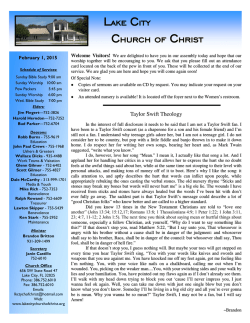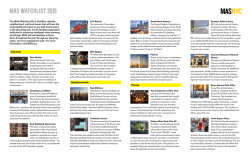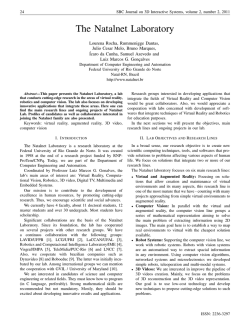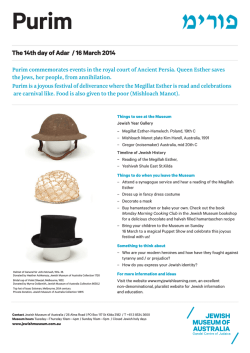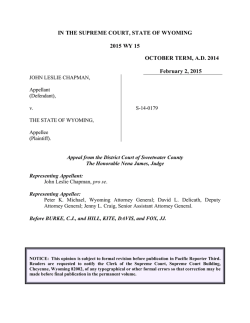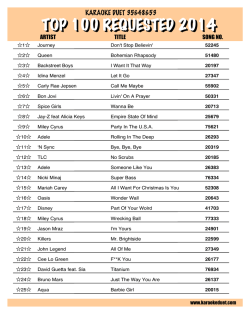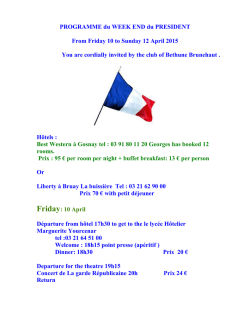
i1JieticanJMuseum
i1Jietican JMuseum oxfitates PUBLISHED BY THE AMERICAN MUSEUM OF NATURAL HISTORY CENTRAL PARK WEST AT 79TH STREET, NEW YORK, N. Y. I0024 JUNE I 9, I 968 NUMBER 2320 Notes on the Biology of Chapman's Swift Chaetura chapmani (Aves, Apodidae) BY CHARLES T. COLLINS1 In the rolling terrain of the central hills of Trinidad, Frank M. Chapman collected a large series of swifts, among which were eight specimens representing a previously unknown species. These specimens, taken between March 15 and March 27, 1894, near the town of Caparo, Caroni County, were described by Hellmayr (1907) as Chaetura chapmani. Nine years later, Cherrie (1916) described a new subspecies of this swift from a unique specimen collected in the Mato Grosso region of Brazil. At present, 60 years after its description, a total of 49 specimens of Chapman's Swift have been collected in the area extending from Panama to Brazil. Little is known of its general biology, however, and its nest is as yet undescribed. Since 1962 I have been studying the biology of swifts in Trinidad and have often observed Chapman's Swift in the field, captured and banded a number of individuals by means of mist nets (Collins, 1967), and found one nest of this species. This information and experience, along with a review of the extant museum specimens, form the basis of the present paper. I am grateful to Mrs. Jocelyn Crane Griffin and the Department of Tropical Research of the New York Zoological Society for their many 1 Chapman Research Fellow, Department of Ornithology, the American Museum of Natural History; Department of Biology, Fairleigh Dickinson University, Madison, New Jersey. 2 AMERICAN MUSEUM NOVITATES NO. 2320 kindnesses in facilitating my field work in Trinidad, to Dr. David W. Snow for acquainting me with the swifts of Trinidad and for making his notes available to me, and to Mr. Richard P. ffrench for contributing field notes and some of the weight data here included. Mr. Eugene Eisenmann offered helpful comments on the manuscript. I also wish to FIG. 1. Localities of collected specimens of Chaetura chapmani chapmani (circles) and of C. c. viridipennis (stars). The shaded area represents the probable breeding range of C. c. chapmani. thank the curators of the several museums who made specimens available for my study. This study, part of a wider program of field studies of the biology of Neotropical swifts, has been generously supported by research grants from the Frank M. Chapman Memorial Fund, the American Museum of Natural History, and the National Science Foundation (Summer Fellowship for Graduate Teaching Assistants, 1964). This work was completed while I was attending the University of Florida. Chaetura chapmani is a moderate-sized swift, although it is one of the larger members of this genus in the New World and the largest of the 1968 COLLINS: CHAPMAN'S SWIFT 3 four species of Chaetura occurring in Trinidad. It is dark blackish brown on the wings, back, nape, and crown, whereas the rump and upper tail coverts are lighter brown or grayish brown. The under parts are also brown to grayish brown, although somewhat lighter on the throat. Specimens of birds in fresh plumage exhibit a distinct greenish iridescence to the feathers of the darker areas. This is purely a structural gloss. With the natural wear of the feathers, it changes from the greenish to a bluish purple gloss and eventually to a dull, completely lusterless black-brown shortly before the annual molt. In the field, C. chapmani appears to be a dark bird, although noticeably browner on the rump and under parts and larger than its Trinidadian congeners. In other parts of its range it would appear very similar to C. pelagica and in color, but not in size, to some races of C. vauxi. The superficial resemblance of the three closely related and largely allopatric species, C. chapmani C. vauxi (including C. richmondi), and C. pelagica, has led to the suggestion that they be considered races of a single species (Lack, 1956). I think that there are sufficient morphological differences, however, as pointed out by Wetmore (1957), for maintaining both C. chapmani and C. vauxi as distinct species. There is no significant sexual dimorphism in size or coloration in C. chapmani. There is, however, a pronounced size difference between the two races, particularly in wing length. MEASUREMENTS1 Chaetura chapmani chapmanz2: Seventeen males: wing (chord), 116-121.5 (118.8); tail, 39-45.5 (41.7); culmen from nostril, 3.0-3.75 (3.35); tarsus, 11.3-13.5 (12.1). Sixteen females: wing (chord), 116-123.5 (119.9); tail, 40-44 (41.8); culmen from nostril, 3.0-3.5 (3.22); tarsus, 11.5-13.5 (12.0). Chaetura chapmani viridipennis: Five males: wing (chord), 127-135 (130.5); tail, 41-45 (42.6); culmen from nostril, 3.5-3.75 (3.56); tarsus, 12.25-15.5 (13.5). Five females: wing (chord), 127-134.5 (130.2); tail, 40.5-44 (42.2); culmen from nostril, 3.5-3.75 (3.65); tarsus, 12.25-15.5 (13.1). In the original descriptions C c. chapmani was said to have a bluish In millimeters; means are in parentheses. The measurements of C. chapmani chapmani do not include five unsexed specimens of this race and one specimen not examined in this study. 2 4 AMERICAN MUSEUM NOVITATES NO. 2320 purple iridescence and C. c. viridipennis a greenish iridescence. Subsequent authors have continued to consider this greenish iridescence among the subspecific differences (Cory, 1918; Naumburg, 1930). As mentioned above, however, these colors are but two stages in the progressive change from the bright greenish iridescence of the fresh new feathers to the dull and lusterless black-brown of very worn feathers. Molting specimens clearly illustrate the sharp contrast between these extreme conditions. It must be said, however, that at the time these races were described the only specimens available were the unique and fresh-plumaged type of viridipennis, and a series of chapmani all in the same intermediate stage of feather wear. Extremely worn specimens and ones showing signs of molt have only recently become available. Change in the iridescent color of feathers due to wear is widespread among the Apodidae and is particularly noticeable in Hirundapus caudacuta (Ferguson-Lees, 1960; personal observation). A similar color change has been recorded for other species of Chaetura, for example, C. vauxi aphanes (Sutton, 1948) and C. pelagica (Sutton, 1928). RANGE Chapman's Swift occurs throughout much of the northern half of South America (fig. 1). Chaetura c. chapmani seems to be resident throughout its range and is represented by specimens taken at various times of the year in Panama, Venezuela, Trinidad, Guyana (former British Guiana), Surinam, French Guiana, and northeastern Brazil in the states of Amapa and Para. The southernmost record is a single specimen from Beneviates in Para (not "Benevides" as spelled by Griscom and Greenway, 1941, p. 166). Three additional specimens with locality designations of "Brazil" are assumed also to have come from the state of Para or the state of Amapa. Hellmayr (1907), however, thought that one of these was "of the unmistakable Cayenne-make" of skin. Chaetura c. viridipennis has been recorded from only four localities: Doze Octobre in- Mato Grosso (February), and Rio Iquiri in Acre (September), Brazil (Pinto and Camargo, 1954); and two localities in the department of Antioquia, Colombia (March-April). As yet Chaetura c. chapmani has not been recorded from Colombia but must be expected to occur in at least the northern parts and thus possibly to overlap the range of C c. viridipennis during some months of the year.' 1 An additional specimen of C. c. viridipennis was collected at Balta on the Rio Curanja, department of Loreto, Peru, on July 15, 1966 (Louisiana State University, Museum of Zoology), and is reported here through the kindness of Dr. George H. Lowery, Jr. COLLINS: CHAPMAN'S SWIFT 1968 5 BREEDING SEASON Direct information on the breeding season of Chapman's Swift is confined to observations on one nest in Trinidad which contained eggs that hatched in early June. Indirect information can also be derived from five specimens showing evidences of the annual molt which begins shortly before the conclusion of breeding. These specimens, taken from .,: . . FIG. 2. Nest site of Chapman's Swift in a cement manhole, Waller Field, Trinidad. June 26 to August 23 in Trinidad, Guyana, and Panama, were all in the early or middle stages of wing molt. Additional birds banded and released in Trinidad were completing their primary molt in the middle of October. This pattern of late spring to early fall (rainy season) breeding and molt is typical for most swifts in Trinidad and northern South America (Collins, 1968; Snow and Snow, 1964). No direct breeding information is available for C. c. viridipennis, and there are no specimens showing signs of molt. It is possible, however, to estimate the period of breeding and molt from the date of occurrence of fresh-plumaged specimens and also from very worn-plumaged speci- 6 s~ ~ AMERICAN MUSEUM NOVITATES NO. 2320 mens that display the wear-associated changes in color. This indirect information indicates that C. c. viridipennis breeds much later than C. c. chapmani, possibly as much as five to six months later (NovemberJanuary). Such a breeding pattern is consistent with the occurrence of a fresh-plumaged bird (the type) in February, and of worn-plumaged birds (six Rio Iquiri specimens similar in color to pre-breeding specimens of C. c. chapmant) that showed no evidence of molt in September. | I _^ |~~~~~~~~~~ FIG. 3. Brushy savanna portion of Waller Field, Trinidad. The nest site of a Chapman's Swift in a manhole was found on the slight rise near the center of the photograph, just to the left of and beyond the figure of the man. The available specimens from the probable breeding season are all from the southern parts of the range (southern Brazil). It is thus quite likely that this race breeds south of the equator during the months of the northern winter, which are the southern spring and summer. It would thus occur in the northern parts of its range (Colombia) only as a transequatorial migrant during the months of the northern spring and summer, which correspond to the southern autumn and winter. Further information on the dates of occurrence of C. c. viridipennis in the various parts of its total range is needed. Such situations, involving both a sedentary subspecies in northern South America and a transequatorial migratory one breeding on a different schedule farther south, are quite common, as evidenced by at 1968 COLLINS: CHAPMAN'S SWIFT 7 least one other species of swift, Chaetura andrei (Sick, 1959; Collins, unpublished). It must be pointed out that two of the three specimens of C. c. vyridipennis collected by M. A. Carriker, Jr., in Colombia bear the notations "TE" and "OE." These are presumably meant to indicate the presence of enlarged gonads in these specimens. Considering the early stage of feather wear of these specimens and the absence of additional information on gonad size, I believe these notations should not be regarded as evidence of breeding. This race, as noted above, probably breeds several months earlier and many hundreds of miles farther south. NESTING Under natural conditions, Chapman's Swift, as do other members of the genus Chaetura, presumably nests in hollow trees. The only nest that was found, however, was in a subterranean, cement manhole (fig. 2) on a brushy savanna near Valencia, Trinidad (fig. 3). This manhole and others like it had been used for some years as nesting and roosting sites by Short-tailed Swifts, Chaetura brachyura (Snow, 1962; Collins, 1968). The nest was first observed on April 26, 1963, when it appeared to be only half complete. It was about 8 inches from the top of the manhole and thus slightly below ground level. By the first week in May the nest was nearly complete, and the first egg was noticed on May 6. The nest was again empty on May 8 and remained so through May 13. When next visited on May 17, there were two eggs in the nest, but no adult was incubating. On subsequent visits from May 20 to June 2 one adult was present at all times, incubating the two eggs. The first egg hatched on June 3; the second, on June 4. When visited on June 5, the nest was again empty and remained so for the rest of the nesting season. No adults were observed roosting in the manhole after June 5. The nest began to come loose from the manhole wall about three weeks later and was removed, it is now in the collections of the American Museum of Natural History. Losses of eggs and young of C. brachyura in these manholes were usually high, although the predator was never identified. No further nests were found in 1964, although several adults and flying young were captured, along with post-breeding flocks of C. brachyura, in nearby manholes from August 23 to October 28 (fig. 4). The nest of Chapman's Swift was a shallow half-saucer made of twigs 25-65 mm. long and usually only 1-2 mm. in diameter (fig. 5). The dimensions of the nest were as follows: width at greatest point along rim, 6.9 cm.; greatest distance from back to front rim, 5.9 cm.; }rkit<*_9'.r-^tXgk, NO. 2320 AMERICAN MUSEUM NOVITATES 8 -- / w .' * 4 it :4 ,. ,1 4 b -S47 . .;, ., r -A se \ -.t FIG. 4. Chapman's Swift (with lighter-colored throat) roosting tailed Swifts in a manhole on Waller Field, Trinidad. among Short- depth from rim to bottom of nest, 2.4 cm. In general size, form, and construction this nest was very similar to nests described for other species in this genus. greatest 1968 COLLINS: CHAPMAN'S SWIFT 9 The clutch size of most New World species of Chaetura ranges from one to seven and averages from 3.6 to 5.3 in different species (Collins, 1968). Second clutches are somewhat smaller. The two eggs successfully incubated by C. chapmani may represent a normal replacement clutch of two or perhaps the second and third eggs of a normal clutch of three interrupted by the loss of the first egg. Further observations A1%-_N1, f )I .1 4 .Nwf, I /1 ..e.i-i X, . If 1 FIG. 5. Nest of Chapman's Swift. would be expected to show that C. chapmani has an average clutch size similar to that of its congeners. If it be assumed that the two eggs of C. chapmani were laid at an interval of one every other day, which seems to be the typical pattern in this genus, the first egg was laid on either May 14 or May 15; the second, on May 16 or May 17. The incubation period from the laying of the last egg of the clutch to the hatching of the first egg would therefore be 17 or 18 days, a period that is in agreement with the information for other Chaetura swifts. The two young of C. chapmani, as observed on June 4, when less than 10 AMERICAN MUSEUM NOVITATES NO. 2320 48 hours old, were flesh-pink in color, with slight traces of grayish coloration on the claws and bill. Each nestling weighed 11/2 grams, was devoid of any natal down, and had a well-formed whitish egg tooth on the tip of the upper mandible. BODY WEIGHT Weight data for Chapman's Swift in Trinidad are available for 16 adults and eight juvenals. Adult weights obtained during the months of March, April, June, August, October, and November, during several years, ranged from 21¾/4 to 28 grams and averaged 24.7 grams. There was no apparent seasonal variation in adult weight, as was also true of C. brachyura and Cypseloides rutilus in Trinidad (Collins, 1968). The body weights of eight juvenal swifts captured between August 23 and October 29, 1964, were noticeably lower than those recorded for adults during the same period. As has been shown previously for other species of Chaetura, juvenals can be distinguished because they are in completely fresh plumage at a time when adults are in worn plumage or early stages of wing molt. Juvenal weights ranged between 20¾/4 and 24/4 grams and averaged only 22.7 grams, whereas 10 of the adults captured during the same period averaged 24.5 grams. No difference in the mean weight of adults and juvenals was found for either C. brachyura (Collins, 1968) or C. pelagica (Coffey, 1958). No weight information is available for the larger C. chapmani viridipennis. MOLT Observations on molt were made in the field in Trinidad on birds captured at roost sites in manholes and birds mist-netted in the Northern Range. The sequence follows the general pattern shown by other Chaetura swifts in Trinidad (Snow, 1962, p. 124; Collins, unpublished). The primaries are replaced in order from innermost to outermost. The secondaries and tail feathers begin to be replaced some time after primary molt has begun, but are completely replaced before the primary molt has finished. The secondaries are replaced in order, starting with the outermost and moving inward. The longer group of innermost secondaries, or "tertials," however, are replaced as a unit during the early stages of the molt of the "typical" secondaries. The tail molt is centripetal. Both wing and tail molt are generally symmetrical. Juvenal birds do not molt their remiges or rectrices during the first autumn, but do show signs of a partial, or possibly complete, molt of juvenal body feathers in late September and October. 1968 COLLINS: CHAPMAN'S SWIFT 11 WING-CLAPPING DISPLAY A wing-clattering or wing-clapping display while at a nesting or roosting site has been recorded for several species of Chaetura. In its usual form as described for C. pelagica (Fischer, 1958, p. 55): ". . . a bird will slowly raise its wings until they are perpendicular to the body and fully outstretched. [See Fischer, 1958, fig. 9, p. 91.] The legs are almost straight, thus holding the swift's body quite far from the surface to which it is clinging. Then the bird leaps backward into flight, and snaps, or claps its wings together producing a sound resembling the wing clapping of a Rock Dove (Columba livia) as it flies off a building. In the short time the swift is in the air it produces from three to six snaps. Almost without exception the bird lands on the original surface within two feet of the last place to which it clung." Snow (1962) also reported the same sort of display by C. brachyura, although he also stated that "after a few bursts of clattering a roosting clump becomes broken up, with the birds evenly scattered on the sides of the hole." My observations on both C. brachyura and C. chapmani indicate a striking difference with respect to this display. On several evening visits, one or both of the roosting adults of C. chapmani performed this wing-clapping display essentially as described by Fischer for C. pelagica. On the other hand, C. brachyura went through the same motions, with the exception that the feet usually did not leave the wall and the clapping was confined to a single downward clap, seemingly more against the wall of the roost than against the opposite wing. As also described by Snow, a tight roosting clump of C. brachyura soon breaks up and spreads out, accompanied by general fluttering noises and some wing-clapping. Once spread out, however, any individuals continuing to display only rarely leave the wall and then for no more than a couple of claps, and not three to six. Similarly, Chaetura andrei seems to confine this display to only a single clap, while continuing to hold on to the wall of the roosting cavity (Sick, 1959). Observations on others of this genus are as yet unavailable. ECOLOGY Field notes on the ecology of Chapman's Swift are confined to Trinidad, where the bird has been observed numerous times in recent years at various places on the island and during most seasons of the year. The original series by Chapman came from a locality on the north side of the low central hills. Several individuals of this species were seen on the southeast side of these hills in June, 1964, in company with Chaetura cinereiventris and C. spinicauda (Collins and ffrench, personal 12 AMERICAN MUSEUM NOVITATES NO. 2320 observation). Chapman's Swift is most frequently seen as isolated individuals, occurring at higher elevations in the Northern Range and particularly in the upper parts of Arima Valley, usually in company with parties of C. cinereiventris. It has occasionally been seen lower down, and the only breeding site and roosting sites found in this study were on a brushy savanna portion of Waller Field near the foot of the North- FIG. 6. Upper portion of Arima Valley, Trinidad, where Chapman's Swifts were frequently observed. ern Range (fig. 6). Also, one bird was collected at nearly sea level on the edge of Bush-Bush Forest in Nariva Swamp (Worth, 1967). On this occasion there was a dense and low cloud cover, and numbers of normally high-flying swifts were foraging near the ground. In general, Chapman's Swift seems to forage mostly over wooded and hilly terrain at a variety of elevations, although appearing to show a slight preference for somewhat higher forested areas. SPECIMENS EXAMINED Abbreviations employed for the various collections contributing specimens for this study are as follows: 1968 COLLINS: CHAPMAN'S SWIFT 13 A.M.N.H., the American Museum of Natural History A.N.S.P., Academy of Natural Science of Philadelphia B.M., British Museum (Natural History) C.M., Carnegie Museum, Pittsburgh C.N.H.M., Field Museum of Natural History (formerly Chicago Natural History Museum) C.O.P., Coleccion Ornitologia Phelps, Caracas, Venezuela P.M.Z., Princeton Museum of Zoology S.P., Secretaria da Agricultura, Departmento de Zoologia, Sao Paulo, Brazil T.R.V.L., Trinidad Regional Virus Laboratory, Port of Spain U.M.M.Z., University of Michigan Museum of Zoology, Ann Arbor U.S.N.M., United States National Museum, Smithsonian Institution, Washingington, D.C. Chaetura chapmani chapmani PANAMA: Gatun, Canal Zone (P.M.Z., A.N.S.P.); Mandinga, Comarca de San Blas (2, U.S.N.M.). VENEZUELA: Territory of Amazonas, Rio Sipapo (C.O.P.). State of Sucre, "Trapa" (=?Irapa), Marino (C.O.P.). State of Zulia, Perija, Aturita (Pons Collection, Maracaibo; specimen not examined). TRINIDAD: St. George County, Carenage (B.M.); Waller Field (3); Arima Valley; Heights of Aripo. Caroni County, Caparo (10, A.M.N.H., M.C.Z., U.S.N.M., S.P.). St. Andrew County, Valencia. Nariva County, Bush-Bush Forest (T.R.V.L.). GUYANA (FORMER BRITISH GUIANA): Bartica (2); "Demerara" (A.N.S.P., M.H.N.P.). SURINAM: Zuid River, Kaiserberg Airstrip (C.N.H.M.). FRENCH GUIANA: Cayenne (4 C.M., U.M.M.Z.). BRAZIL: Territory of Amapa, Rio Amapari (U.S.N.M.). State of Para, Beneviates (C.M.). "Brazil" (3, B.M., A.N.S.P.). Chaetura chapmani viridipennis BRAZIL: State of Mato Grosso, Doze Octobre (type). Territory of Acre, Rio Iquiri (6, S.P., A.M.N.H.). COLOMBIA: Department of Antioquia, Rio Taraza (2, U.S.N.M.); El RealRio Nechi (U.S.N.M.). SUMMARY Recent field work in Trinidad and a review of museum specimens has provided additional information on the poorly known Chapman's Swift, Chaetura chapmani. Details are given on a color change associated with plumage wear and also measurements and ranges of the two recognized subspecies. Chaetura c. chapmani is a sedentary breeder in the area from Panama to the mouth of the Amazon River. It breeds in the early part of the 14 AMERICAN MUSEUM NOVITATES NO. 2320 rainy season, which is during the northern spring and summer. Chaetura c. viridipennis appears to breed south of the equator in southern Brazil during the northern winter and to migrate to Colombia during the northern summer months. Observations on one nest of Chapman's Swift found in Trinidad are presented. The nest, clutch size, incubation period, and appearance of the young are very similar to those of other congeners. Data are presented on the weight and molt of adults and juvenals of this species in Trinidad. A wing-clapping display is described which differs somewhat from that described for some other species of Chaetura. Notes on the ecology of C. chapmani in Trinidad are presented. LITERATURE CITED CHERRIE, GEORGE K. 1916. Some apparently undescribed birds from the collection of the Roosevelt South American Expedition. Bull. Amer. Mus. Nat. Hist., vol. 35, pp. 183-190. COFFEY, LULA C. 1958. Weights of some Chimney Swifts at Memphis. Bird-Banding, vol. 29, pp. 98-104. COLLINS, CHARLES T. 1967. Mist-netting Neotropical swifts. Ebba News, vol. 30, pp. 73-75. 1968. The comparative biology of two species of swifts in Trinidad, West Indies. Bull. Florida State Mus., vol. 11, no. 5, pp. 257-320. CORY, CHARLES B. 1918. Catalogue of birds of the Americas. Part 2. Publ. Field Mus. Nat. Hist., zool. ser., vol. 13, pp. 1-315. FERGUSON-LEES, I. J. 1960. Studies of less familiar birds. 107. Needle-tailed Swift. Brit. Birds, vol. 53, pp. 431-433. FISCHER, RICHARD B. 1958. The breeding biology of the Chimney Swift Chaetura pelagica (Linnaeus). Bull. New York State Mus. Sci. Serv., no. 368, 139 pp. GRISCOM, LUDLOW, AND JAMES C. GREENWAY, JR. 1941. Birds of lower Amazonia. Bull. Mus. Comp. Zool., vol. 88, pp. 83344. HELLMAYR, CHARLES E. 1907. [No title.] Bull. Brit. Ornith. Club, vol. 19, pp. 62-63. LACK, DAVID 1956. A review of the genera and nesting habits of swifts. Auk, vol. 73, pp. 1-32. NAUMBURG, ELSIE M. B. 1930. The birds of Matto Grosso, Brazil. Bull. Amer. Mus. Nat. Hist., vol. 60, pp. 1-432. 1968 COLLINS: CHAPMAN'S SWIFT 15 PINTO, 0. M. DE O., AND E. A. DE CAMARGO 1954. Resultados ornitologicos de una expedicao ao Territorio do Acre pelo Departamento de Zoologia. Papeis Avulsos, vol. 11, pp. 371-418. SICK, HELMUT 1959. Notes on the biology of two Brazilian swifts, Chaetura andrei and Chaetura cinereiventris. Auk, vol. 76, pp. 471-477. SNOW, DAVID W. 1962. Notes on the biology of some Trinidad swifts. Zoologica, vol. 47, pp. 129-139. SNOW, DAVID W., AND BARBARA K. SNOW 1964. Breeding seasons and annual cycles of Trinidad land-birds. Zoologica, vol. 49, pp. 1-39. SUTTON, GEORGE M. 1928. Notes on the flight of the Chimney Swift. Cardinal, vol. 2, pp. 8592. 1948. Richmond's Swift in Venezuela. Occas. Papers Mus. Zool., Univ. Michigan, no. 505, pp. 1-6. WETMORE, ALEXANDER 1957. Species limitation in certain groups of the swift genus Chaetura. Auk, vol. 74, pp. 383-385. WORTH, C. BROOKE 1967. A naturalist in Trinidad. Philadelphia, J. B. Lippincott Co., 291 pp.
© Copyright 2025

